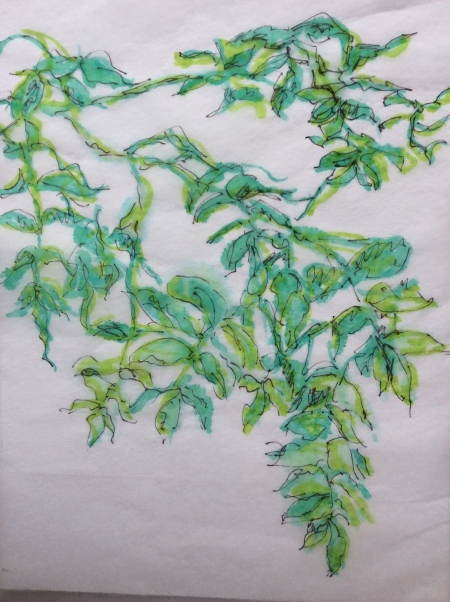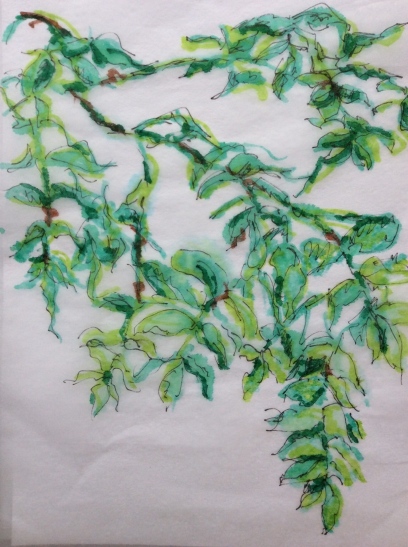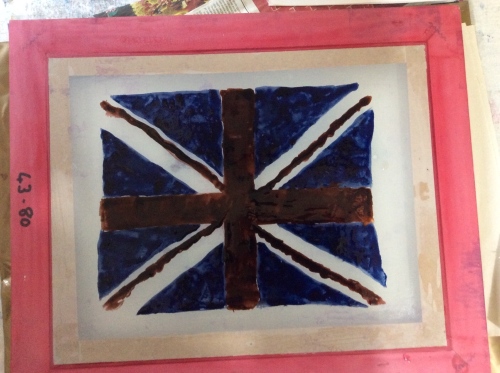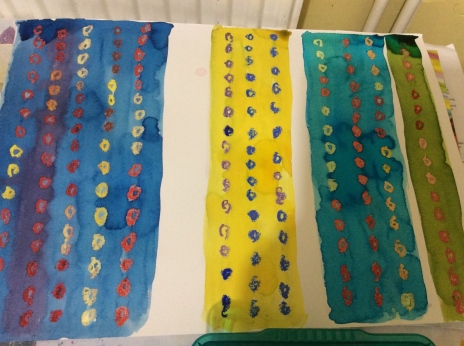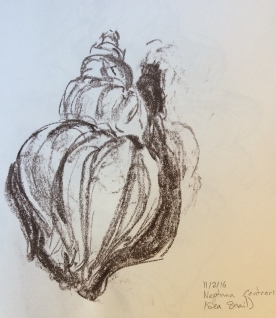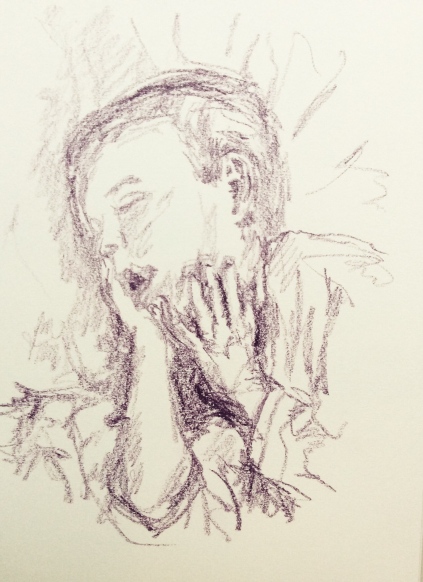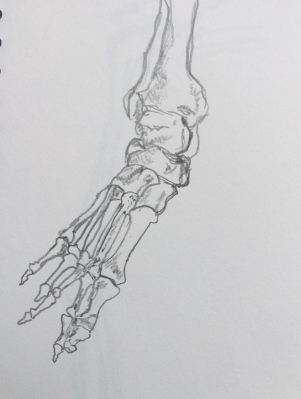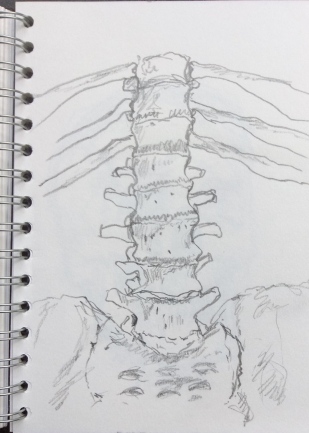6 June 2016
I have started to develop some of my ideas from my work on the ash tree branches and I have been collecting tree-related photographs and making drawings and analogies in support of Textiles 1: Exploring ideas, Assignment 5, Personal project.
Ash tree branch:
I took the initial pen and ink drawing –
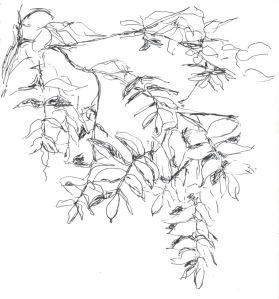
I did some experimentation with free-machine embroidery, using plain black thread on paper, just to see how the marks compared with pen and ink. The results are shown below:

I was quite surprised at just how similar the machine stitching was as a mark-making technique. Having done very little machine embroidery, it took me a while to get used to controlling the direction of the needle, but I am quite pleased with the results for a first attempt.
I then decided I would copy the image using my inkjet printer scanner and experiment with adding texture by machine embroidering over the printed outline (again on paper). The results are shown below:
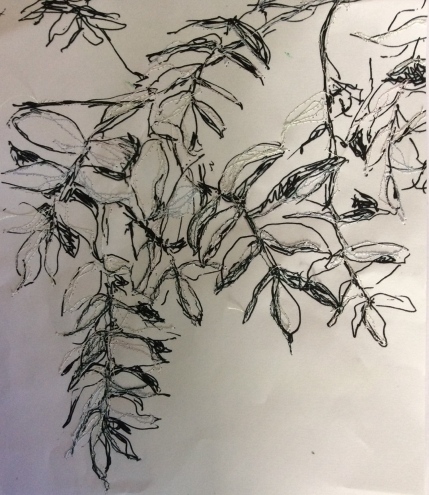
The top thread was a very pale machine embroidery thread, so does not have much impact on overall shading/colour, although it does add an interesting textural element. I purposely let the machine needle stray outside the leaf outlines because I think this adds to the impression of foreground and background.
My plan for further exploring this idea is to think about colour and how it could be introduced/combined (see my previous post). Also, I might consider the method of outlining, think about fabric or paper as alternatives backing materials and revisit layering.
First thoughts on the Plane tree leaf:
A friend on Facebook posted the photograph below and was kind enough to give me permission to use it for my textile work:

(Photograph above: copyright of Paul Mead)
The water droplets are interesting, but my first thoughts were regarding the prominent veins and the contrast between the glossy, waxy leaf and the textured soggy earth. The angular shapes of the outline also caught my eye, being instantly recognisable as a leaf-form.
My first analogy was an experiment using Japanese paper and hand-stitching. I either trapped different thicknesses of yarn between running stitches, or just trapped a fold of paper between the stitches. I wanted to see if I could create the shapes of the leaf ribs and discover how the paper would respond to being manipulated in this way.

I’m really pleased with this analogy. The paper has crumpled, adding to the likeness. Naturally, the next stage would be to introduce colour, maybe by screen or inkjet printing. However, my aim is not to attempt to recreate a representation of the leaf in textiles, so I am thinking firstly towards abstraction – maybe cutting sections, joining different pieces with stitching, or using different colours or materials (be they fabric, laminate or paper). Some sketching work will probably be needed first, to explore composition.
Pine tree, Snape Maltings:

I made this sketch on 23 May during a visit to Snape. I like the asymmetry of the tree (due to it being in a coastal, windswept position) and the wide spreading top. It reminded me of some of the sinuous shapes in the drawings and paintings of Margaret MacDonald Mackintosh. Taking an idea from her work I have thoughts of making a mirror image and using the images as a symmetrical pair, this way playing with similarity and difference (i.e. symmetry generated by the mirror images, contrast because individually they are highly asymmetrical).
Oak tree studies from “Thornham Walks”:
Thornham walks is a parkland which contains many ancient trees, particularly oaks. There is a good variety of species and it is possible to get close to the trees for observation and sketching.
The first oak tree I sketched stood in an open field. The analogy was drawn using charcoal, Conte pencil and soft pastel.

I wanted to capture the highlights and shadows formed by the canopy of leaves and the shapes of branch sections which were clearly visible. The overall shape and proportions of the tree was also important. My thoughts for developing this analogy are to maybe concentrate in a small area, and develop and intensify the feelings of light and shade. I think the mark-making is also interesting; being mainly dots it has a loose resemblance to Pointillism.
I was attracted to a second tree because of the extreme effects of perspective, which I am disappointed to have captured inadequately.

The oak branches had that very distinctive, “dislocated joint” feel about them; the trunk being several meters away from where I was standing and the branches, coming very close and overhead. The idea of making this analogy was to capture the branch shapes and negative space. I do like aspects of the texture and shapes of the drawing, but I would probably need to return and make another sketch if I wanted to develop the idea.
Several oak trees had dead uppermost branches (although the branches below were clothed in leaves). I made a charcoal sketch because I am particularly interested in the silhouettes – they almost feel eerie and menacing.
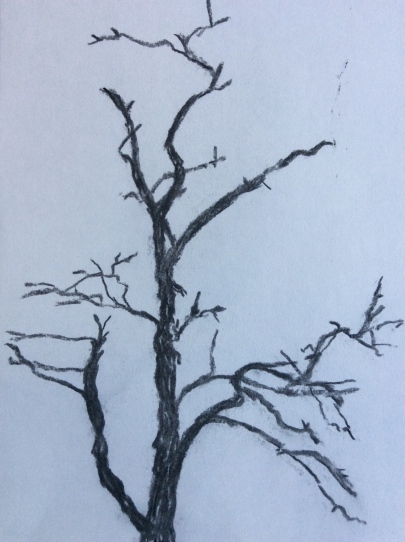
A separate oak in the centre of the park showed interesting “lop-sided” ovals where lower branches had been cut.
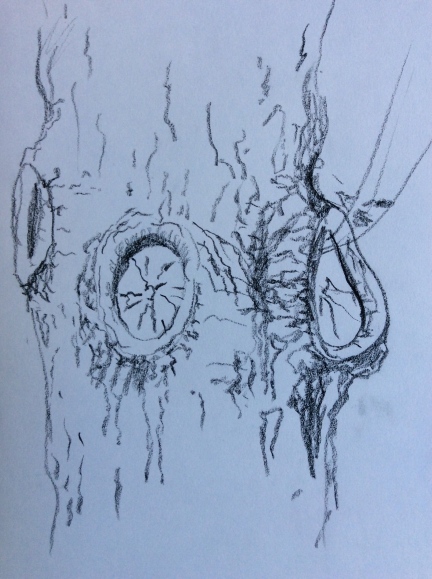
I was really attracted to the different shapes and textures and I feel that there is a lot of scope for simplifying and developing this imagery. At the moment it is suggesting a printing project or pattern development.
A smaller oak tree interested me because it had lots of fine growth protruding horizontally from the main trunk – The areas where the growth originated were gnarled and knobbly. I like the contrast between the fine shoots and the thick heavily textured bark, although I’m not sure at the moment how I could develop this drawing/idea.

I made an analogy of the bark texture using white Conte pencil on black paper, which is simplified in terms of tone, concentrating instead on the shapes made by areas of light and shade.
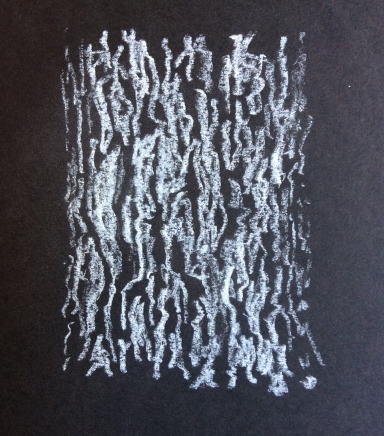
Finally, I took two bark rubbings from an oak tree trunk. The first is using a charcoal block:

I love the quality of these marks, and would love to be able to reproduce this somehow in textile, possibly with an inkjet printer onto fabric. It would need to be combined with another technique/project which needs some thought as I continue to develop my other samples/analogies.
The second rubbing I made was using wax candle. When I got home, I applied a wash of Indian ink, Koh-i-noor dye-based watercolour, and an application of oil pastel to achieve a highly textured surface.
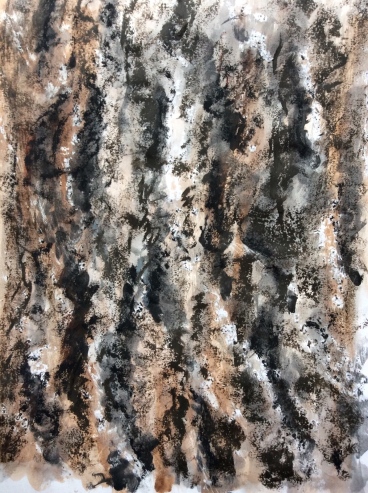
Walnut bark:
Using the same methods as above, I made two similar analogies from walnut bark. The texture was quite different and much more regular.
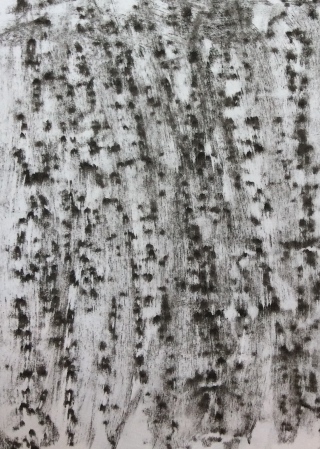
Above is the charcoal block rubbing.

And next a candle wax rubbing with ink wash and oil pastels. Thinking about textile analogies, what I would not want to do is make a representative textile copy. I will have to give some thought to how or whether I develop this idea further.
Yew tree:
This is my least favourite analogy (which I have included for completeness!). It is a charcoal drawing of a large yew tree. The tree was interesting because it was multi-stemmed – having lots of almost vertical main trunks, with many almost horizontal secondary branches and clothed in fine frond-like leaves/needles. I feel that the charcoal was too heavy and thick to capture this properly.

Coppiced willow:

In deciding to make this pencil sketch, I was attracted to the colour variation in the new leaves, and the contrast between the rough, thick trunk and the soft new leafy growth. My plan is to start with a colour study and maybe try and match some of the textures with fabric or yarn/thread.
Pine trees:
The pine trees at Thornham walks were quite different to the species at Snape. Smaller and with drooping U-shaped branches. My first sketch is a soft pencil drawing in which I try to capture the silhouette of the pine branches and understand how they cross each other and in which directions the needles are pointing.
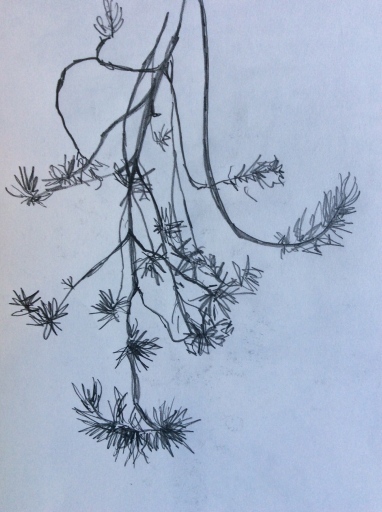
My second sketch is a different tree and probably a different species again. The new growth had pinkish-brown tips and a distinct shape and density differences. I am thinking about simplifying these and arranging them to make a pattern.

Summary:
The work presented in this blog and the one before represents the first stages of my sketchbook work towards Assignment 5 of Textiles 1: Exploring ideas. I anticipate a few more sketches and certainly more development work and experimentation before I start to make samples. I would normally not duplicate my sketchbook in it’s entirety online, however as work-in-progress it needs to be retained over the next few weeks for reference.



























